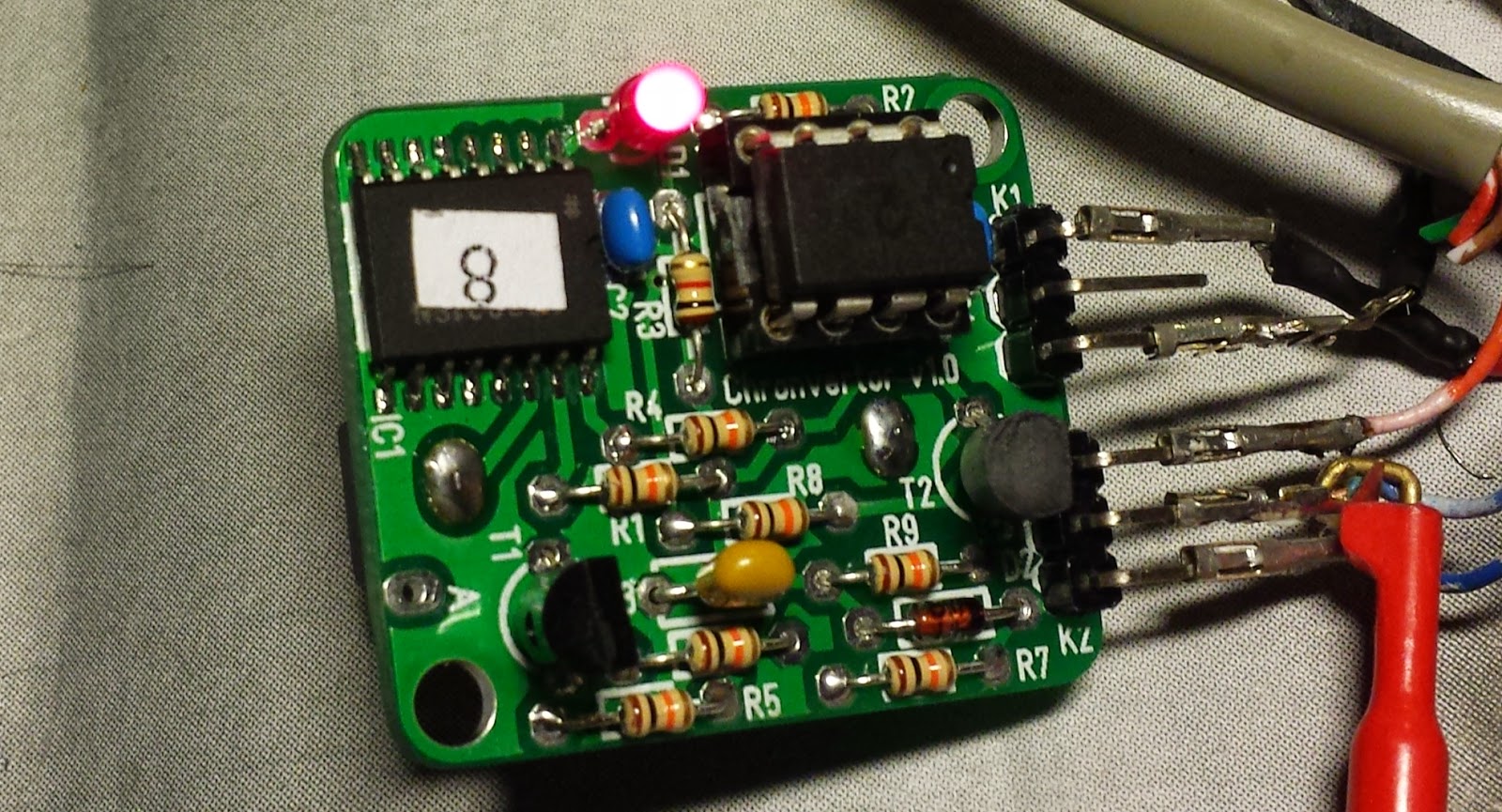I got lucky in an e-bay auction (
from this kind seller) and got this R-855-UM Soviet Union pilot's emergency 121.5MHz transceiver and beacon for $5 + postage. It has an interesting folding whip antenna made of metal "beads" and a stainless steel wire which goes rigid when the wire is tensioned.
Specification
here (in Russian). You can see the battery box there as well. I don't have one but the instructions say to put it in your jacket if the temperature is below zero, so it is round and cuddly! Similar unit in
"radio museum" here.
The operation is simple. Attach and extend the antenna. Top button is RX underneath that is TX and beneath that a slider to lock either or both buttons. Press both for beacon. The power is 0 on pin 3 and -9V on pin 5. Note that means the ground is positive and pin 3 is connected to the chassis. See this illustration of the
Priboi-2C battery pack for the pin out.
Connected to a PP3 battery and a dummy antenna coupled to my Icom 706 (and shielded in aluminium foil for good measure) I can confirm it works on all modes. It draws about 73mA in TX and 8.5mA in RX. Next step is to make a modern waterproof battery box.
More photos
 |
| Showing the power connector and the tensioning mechanism for the antenna. The screw bottom left is to equalize pressure when there is an altitude change (which makes the microphone work better). |
 |
| To the right the receive button, left the slide to lock and in the middle the transmit button. |
 |
| Thanks to Klaus-Peter dh4py for this photo showing the connections on the battery (female) connector. He says 9.4V. It is not exactly the same as a 5 pin DIN. |
 |
| The mechanism for the antenna. It works rather like a "push puppet" toy that stands up when the string through its bead limbs tension. In this case the tension is provided not by a string but by a kind of highfield lever mechanism. Given the tradition of wooden toy making in Russia I wonder if that is where they got the idea. |
 |
| Schematic (from http://supreg1.narod.ru/files/R855UM.gif) with my annotations indicating what I think the main blocks are. I think the crystal is half the transmit frequency and there is a frequency doubling circuit. |
Here is an approximate translation of the instructions on the unit: (from Google translate and some guess work)
RADIO R 855-UM
Option C
Works with internal
microtelephones [maybe it means the speaker/microphone, also works with phones and mic in pilot's helmet]
1. Cock [ie tension with highfield mechanism] and connect antenna
to the transceiver. Unlock button.
2. Connect the battery to the
radio station itself.
3.RECEPTION: press "Receive" [ПРИЕМ that is the top button]
and listen. Noise in the phone indicates normal operation of the
receiver.
4. Transmit Press "ПРД"
[that is the lower button]
bring the microphone to his mouth and speak clearly
5 TON [tone, the alarm tone] (MAYDAY): press
together Transmit and Receive
6.
In continuous operation in
one mode, press and lock buttons
[ie with the ФИКСАТОР - LATCH]
Working with headsets
7. The radio, battery and
headset connected through [adapter?]
Work in the "Komar-2M" [I think this is an inflatable unit with an antenna see this article]
8. The radio and battery are
connected through the umbilical cord. The headset connects to the
halyard [not sure if that is the right word] directly or through an adapter. Adapter type determined
by headset.
9 When operating in
accordance with paragraph 7 and 8 transmission with the internal
microphone
is impossible. Inclusion on the “Receive”
“Transmit" and "Tone" is produced by as in . 3, 4,
5.6.
CAUTION
1. For normal operation
buttons should be pressed all the way. In
the intermediate positions and can be heard when
switching additional tone.
2. If there is a large change in
temperature or pressure loosen [screw] for 3-5 seconds.
3. When the ambient
temperature is below 0 degrees C place the battery under clothing. [to keep it warm!]
And my (possibly incorrect in places) transcription of the Russian
РАДИОСТАНЦИЯ Р
855-УМ
Вариант С
Работа с внутренним
микротелефоном
1. Взведите и
подсоедиите антенну к приемопередатчику.
Расфиксируйте
кнопки.
2. Подключите
батарею к радиостанции непосредственно.
3.ПРИЕМ: нажмите
кнопку «ПРИЕМ» и слушайте. Шум в телефоне
свидетельствует о нормальной работе
приемника.
4. ПЕРЕДАЧА: нажмите
кнопку «ПРД» поднесите микрофон ко рту
и говорите четкою
5.ТОН (МАЯ К): нажмите
вместе кнопки ПРИЕМ и ПРД
6.
При длительной
работе в одном режиме нажмите и
зафиксируйте соответствующие кнопки
Работа со
шлемоФоном
7. Радиостанция,
батарея и шлемоФон соединяются
через переходной
Работа в системе
"Комар-2М"
8. Радиостанция и
батарея
соединяются
через фал. Шлемофон
подключается к разъему фала непосредственно
или через переходник . Тип переходника
определяется шлемофоном.
9. При работе
согласно п. 7 и п. 8 передача с внутреннего
микрофона
невозможна.
Включение на
"ПРИЕМ" ""ПЕРЕДАЧУ" и "ТОН"
производится по п. п. 3, 4 ,5,6.
ВНИМАНИЕ!
1. Для нормальной
работы кнопки должны
быть нажаты до
упора. В промежуточных положениях
и при переключениях
может прослушиваться дополнительный
тон.
2.При большом
перепаде температуры или давления
отверните на 3-5 сек.
3.При окружающей
температуре ниже 0 С батарею местите
под одеждой










